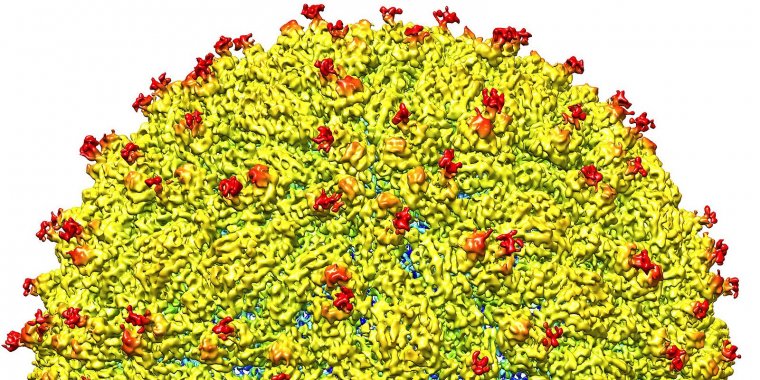| Health / Health News |
Zika virus found to harm adults’ memory and motor system
A study by scientists at the Federal University of Rio de Janeiro (UFRJ) found that the Zika virus, in addition to replicating in the brain of adults, also damages the memory and the motor system.

A representation of the surface of the Zika virus. Photo: NIH/Purdue University/Kuhn and Rossmann research groups
Though self-limited and with light symptoms, patients often show a more severe state: Some enter into a coma or must spend more time hospitalized. “So we asked ourselves a question. Researchers had shown the virus replicates in parent cells, which belong to the fetus, to the central nerve. Doesn’t this virus also affect mature neurons? That’s when our approach started,” said neuroscientist Cláudia Figueiredo, one of the research coordinators.
Scientists from UFRJ used healthy tissues of adult patients who had been submitted to brain surgery but had no Zika. After laboratory culture, the researchers introduced Zika virus into this tissue, which has mature neurons. The virus was seen to infect those cells, especially neurons, and replicated in the tissue.
In the meantime, clinical findings indicated that the virus was in the central nervous system, in the cerebrospinal fluid—the liquid around the brain. The researchers then decided to find out what would happen if they infected the brain of an adult animal with this virus “We administered the virus inside the brain of an adult mouse and observed a lot of things,” Figueiredo said.
It was ascertained that the virus replicated in the brain of the adult animal and preferred areas linked to memory and motor control. “And this is exactly what had been altered in the patients when they had the virus and showed a complicated state.” This may happen to adult people as well, the coordinator confirmed. “We’re not sure why, but, when the infection takes place, the virus reaches the central nervous system of some people, but not others. It depends on a number of factors, and it can cause this kind of damage.”
The neuroscientist mentioned that the memory damage happened not just in the adult phase of the infection. It was noticed that symptoms remain even after the infection in the mice was brought under control, and that the virus replicated and had a replication peak that lasted for days.
“Except that, up to 30 days later, the virus is found in low quantities in the brain, and the animal is still alive, though facing memory damage. This damage persists.” The scientist explained that 30 days in the life of an animal are equivalent to two to four years in the life of a human being. “It’s a lot of time.” And she warned that it may be necessary to assess the memory of patients infected after a few years. (Agência Brasil/EBC)
YOU MAY ALSO LIKE





